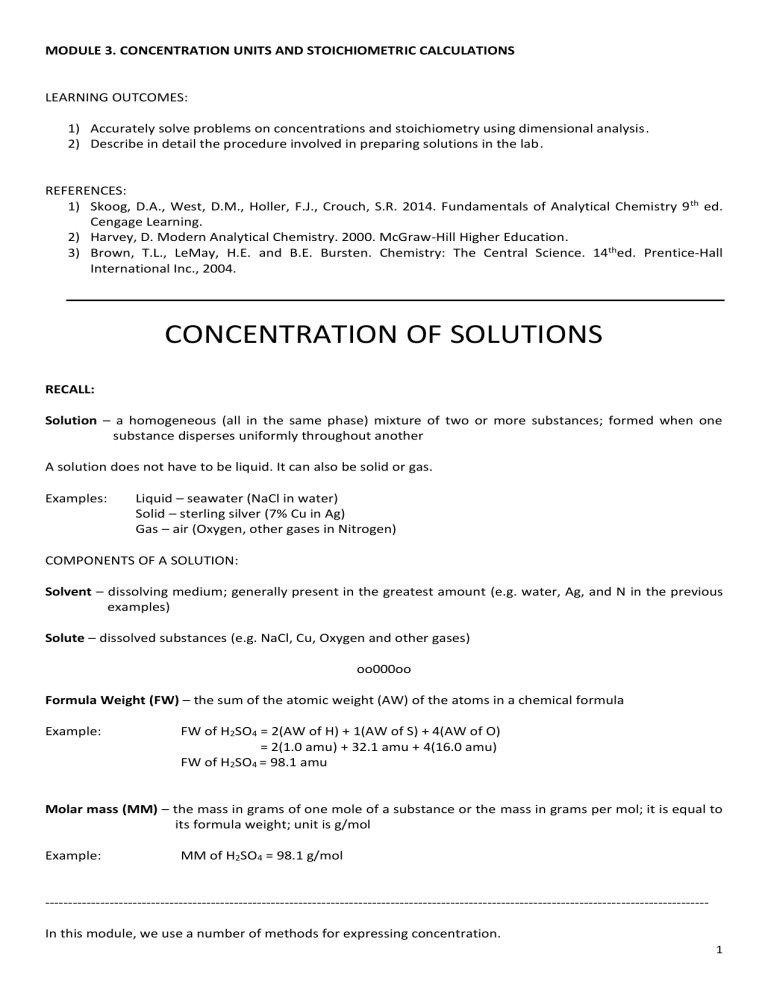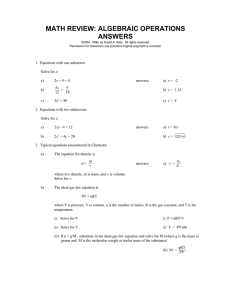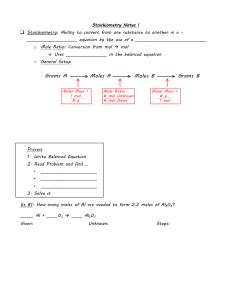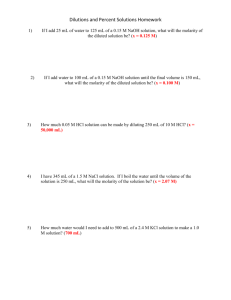
MODULE 3. CONCENTRATION UNITS AND STOICHIOMETRIC CALCULATIONS LEARNING OUTCOMES: 1) Accurately solve problems on concentrations and stoichiometry using dimensional analysis. 2) Describe in detail the procedure involved in preparing solutions in the lab. REFERENCES: 1) Skoog, D.A., West, D.M., Holler, F.J., Crouch, S.R. 2014. Fundamentals of Analytical Chemistry 9 th ed. Cengage Learning. 2) Harvey, D. Modern Analytical Chemistry. 2000. McGraw-Hill Higher Education. 3) Brown, T.L., LeMay, H.E. and B.E. Bursten. Chemistry: The Central Science. 14thed. Prentice-Hall International Inc., 2004. CONCENTRATION OF SOLUTIONS RECALL: Solution – a homogeneous (all in the same phase) mixture of two or more substances; formed when one substance disperses uniformly throughout another A solution does not have to be liquid. It can also be solid or gas. Examples: Liquid – seawater (NaCl in water) Solid – sterling silver (7% Cu in Ag) Gas – air (Oxygen, other gases in Nitrogen) COMPONENTS OF A SOLUTION: Solvent – dissolving medium; generally present in the greatest amount (e.g. water, Ag, and N in the previous examples) Solute – dissolved substances (e.g. NaCl, Cu, Oxygen and other gases) oo000oo Formula Weight (FW) – the sum of the atomic weight (AW) of the atoms in a chemical formula Example: FW of H2SO4 = 2(AW of H) + 1(AW of S) + 4(AW of O) = 2(1.0 amu) + 32.1 amu + 4(16.0 amu) FW of H2SO4 = 98.1 amu Molar mass (MM) – the mass in grams of one mole of a substance or the mass in grams per mol; it is equal to its formula weight; unit is g/mol Example: MM of H2SO4 = 98.1 g/mol -----------------------------------------------------------------------------------------------------------------------------------------------In this module, we use a number of methods for expressing concentration. 1 Concentration – an expression or a general measurement unit stating the relative amount of solute per unit volume or unit mass of solution Concentration = 𝑎𝑚𝑜𝑢𝑛𝑡 𝑜𝑓 𝑠𝑜𝑙𝑢𝑡𝑒 𝑎𝑚𝑜𝑢𝑛𝑡 𝑜𝑓 𝑠𝑜𝑙𝑢𝑡𝑖𝑜𝑛 The table on the right lists the most common units of concentration. 1. MOLARITY AND FORMALITY Molarity or molar concentration – the number of moles, n, of that species that is contained in 1 liter of the solution (not 1 L of solvent) or the number of millimoles of soluter per milliliter of solution; the unit is molar, symbolized by M. 1M=1 𝑚𝑜𝑙𝑒 𝑜𝑓 𝑠𝑜𝑙𝑢𝑡𝑒 𝑜𝑓 𝑠𝑜𝑙𝑢𝑡𝑒 = 1 𝑚𝑚𝑜𝑙 𝐿 𝑜𝑓 𝑠𝑜𝑙𝑢𝑡𝑖𝑜𝑛 𝑚𝐿 𝑜𝑓 𝑠𝑜𝑙𝑢𝑡𝑖𝑜𝑛 Example 3-1: 2 Example 3-2. Example 3-3. Formality – the number of moles of solute, regardless of chemical form, per liter of solution; the unit is formal, F. There is no difference between a substance’s molarity and formality if it dissolves without dissociating into ions. For example, the molarity of glucose (a non-electrolyte, or doesn’t dissociate into ions) is the same as its formality. For substances that are electrolytes or ionizes in solution, such as NaCl, molarity and formality are different. For example, dissolving 0.1 mol of NaCl in 1 L of water gives a solution containing 0.1 mol of Na + and 0.1 mol of Cl-. The molarity of NaCl, therefore, is zero since there is essentially no undissociated NaCl in solution. The solution, instead, is 0.1 M in Na+ and 0.1 M of Cl-. The formality of NaCl, however, is 0.1 F because it represents the total amount of NaCl in solution. Nevertheless, molarity is frequently used and when we state that a solution is 0.1 M NaCl, we understand it to consist of Na+ Cl- ions. The unit of formality is used only when it provides a clearer description of solution chemistry. To simplify the expression of molar concentrations in equations and writing, we write square brackets around a species. Thus, [Na+] is read as the “molar concentration of sodium ions.” 3 2. NORMALITY Normality is an older unit of concentration that, although once commonly used, is frequently ignorned in today’s laboratories. Normality is still used in some handbooks of analytical methods, and, for this reason, it is helpful to understand its meaning. Normality – the number of equivalents of solute per liter of solution; the unit is normal, N Equivalent – based on a reaction unit, which is that part of a chemical species involved in a reaction; symbolized by the small letter n (not to be confused with n for the number of moles) Examples: a. In a precipitation reaction, the reaction unit is the charge of the cation or anion involved in the reaction Thus, n = 2 for Pb2+ (cation) and n = 1 for I- (anion). b. In an acid-base reaction, the reaction unit is the number of H+ ions donated by an acid or accepted by a base. Thus, n = 2 for H2SO4 (acid) and n = 1 for NH3 (base). Note that a solution has a fixed molarity, but its normality depends on how it reacts. c. For a complexation reaction, the reaction unit is the number of electron pairs that can be accepted by the metal or donated by the ligand (a molecule or an ion with at least one pair of unshared electrons available for coordinate bonding with cations. Thus, n = 2 for Ag+ (metal) and n = 1 for NH3 (ligand). d. In an oxidation-reduction (redox) reaction, the reaction unit is the number of electrons released by the reducing agent or accepted by the oxidizing agent. Thus, n = 1 for Fe3+ (oxidizing agent, substance reduced) and n = 2 for Sn2+ (reducing agent, substance oxidized). Normality is the number of equivalent weights (EW) per unit volume Equivalent weight (EW) – ratio of a chemical species’ formula weight (FW) to the number of equivalents, n EW = 𝐹𝑊 𝑛 Thus, N = 𝐸𝑊 𝑉 Consequently, the following simple relationship exists between normality and molarity. N=nxM 4 Example 3-4. 3. MOLALITY Molality is used in thermodynamic calculations where a temperature independent unit of concentration is needed. This uses the solvent’s mass (not solution) in place of its volume, thus, the resulting concentration becomes independent of temperature. Its unit is molal, m. 𝑚𝑜𝑙𝑒 𝑜𝑓 𝑠𝑜𝑙𝑢𝑡𝑒 1 m = 1 𝑘𝑔 𝑜𝑓 𝑠𝑜𝑙𝑣𝑒𝑛𝑡 4. PERCENT CONCENTRATION Three common methods to express concentrations in terms of percent (parts per hundred) are Note that the denominator in each of these expressions is the mass or volume of solution rather than the mass or volume of the solvent. Note also that the first two expressions do not depend on the units used for weight (mass) or volume, whether it be in grams or milligram, in liters or milliliters, as long as the same units are used in the numerator and the denominator. In the third expression, units must be defined because the numerator and denominator have different units that do not cancel. 5 Weight percent is often used to express the concentration of commercial aqueous reagents like nitric acid sold as a 60% (w/w) solution, meaning that the reagent contains 60 g of HNO 3 per 100 g of solution. Volume percent is commonly used to specify the concentration of a solution prepared by diluting a pure liquid compound with another liquid. For example, a 70% (v/v) aqueous solution of ethanol usually describes a solution prepared by diluting 70.0 mL of ethanol with enough water to give 100 mL. Weight-to-volume percent is often used to indicated the composition of dilute aqueous solutions of solid reagents. For example, 5% (w/v) aqueous silver nitrate often refers to a solution prepared by dissolving 5 g of silver nitrate in sufficient water to give 100 mL of solution. Always specify the type of percent when reporting concentrations this way. The potential error resulting from a wrong choice is considerable. For example, commercial 50% (w/w) sodium hydroxide contains 73 g NaOH per liter, which corresponds to 76.3% (w/v) sodium hydroxide. 5. PARTS PER MILLION AND PARTS PER BILLION Parts per million (ppm) and parts per billion (ppb) are mass ratios of grams of solute to one million or one billion grams of sample, respectively. cppm = 𝑚𝑎𝑠𝑠 𝑜𝑓 𝑠𝑜𝑙𝑢𝑡𝑒 x 106 ppm 𝑚𝑎𝑠𝑠 𝑜𝑓 𝑠𝑜𝑙𝑢𝑡𝑖𝑜𝑛 cppb = 𝑚𝑎𝑠𝑠 𝑜𝑓 𝑠𝑜𝑙𝑢𝑡𝑒 x 109 ppb 𝑚𝑎𝑠𝑠 𝑜𝑓 𝑠𝑜𝑙𝑢𝑡𝑖𝑜𝑛 where cppm and cppb are concentrations ins parts per million and parts per billion, respectively. The units of mass in the numerator and denominator must agree so that they can cancel. Ppm and ppb can also be expressed as Example 3-5. 6 6. SOLUTION-DILUENT VOLUME RATIOS The composition of a dilute solution is sometimes specified in terms of the volume of the more concentrated solution and the volume of solvent used in diluting it. The volume of the former is separated from that of the latter by a colon. Thus, a 1:4 HCl solution contains four volumes of water for each volume of concentrated hydrochloric acid. This method of notation is frequently ambiguous in that the concentration of the original solution is not always obvious to the reader. Moreover, under some circumstances, 1:4 means dilute one volume with three volumes. Because of such uncertainties, you should avoid using solution-diluent ratios. 7. p-FUNCTIONS When working with concentrations that span many orders of magnitude, it is often more convenient to express the concentration of that species as a p-function or p-value. p-value – the negative logarithm (to the base 10) of the molar concentrations of that species. For species X, pX = -log [X] The best-known p-function is pH, which is the negative logarithm of [H+]. As shown by the following examples, p-values offer the advantage of allowing concentrations that vary over ten or more orders of magnitude to be expressed in terms of small positive numbers. Example 3-6. Example 3-7. 7 STOICHIOMETRIC CALCULATIONS Stoichiometry – from the ancient Greek words “stoicheion” meaning element and “metron” meaning measure; it is founded on the Law of Conservation of Mass where the total mass of the reactants equals the total mass of the products; is the relationship among the number of moles of reactants and products as represented by a balanced chemical equation A balanced chemical equation gives the combining ratios, or stoichiometry – in units of moles – of reacting substances and their products. For example, in the following equation: The coefficients in a balanced equation indicate both the relative number of MOLECULES (or formula units) in the reaction and the relative number of MOLES. Thus, for the balanced equation above it indicates that 2 moles of aqueous sodium iodide combine with 1 mole of aqueous lead nitrate to produce 1 mole of solid lead iodide and 2 moles of aqueous sodium nitrate. All the species are stoichiometrically equivalent, to each other. 2 mol NaI 1 mol Pb(NO3)2 1 mol PbI2 2 mol NaNO3 The term “stoichiometrically equivalent” means that a definite quantity of one substance reacts with a definite quantity of all the other substances represented in the equation. Example 3-8. Below is a flow diagram for making stoichiometric calculations. It is a three-step process of (1) converting the known mass of substance A (the given) in grams to its corresponding number of moles using the molar mass of A, (2) converting the number of moles of substance A to moles of substance B using the coefficients of the balanced equation, and (3) converting the moles of substance B back to the metric units called for in the answer. Always make sure that the equation is balanced since the coefficients are used in calculations. 8 Example 3-9. Calculate the mass of CO2 produced when 1.00 g of C4H10 is burned based on the following equation: C4H10(g) + O2(g) → CO2(g) + H2O(l) Step 0: Make sure that the equation is balanced. It is not balanced and the balanced equation is 2 C4H10(g) + 13 O2(g) → 8 CO2(g) + 10 H2O(l) Given: mass of substance A (C4H10) = 1.00 g Find: mass of substance B (CO2) Step 1: Convert grams of C4H10 to mole using its molar mass. MM C4H10 = (4 x 12.01 g/mol) + (10 x 1.008 g/mol) MM = 58.12 g/mol 𝑚𝑜𝑙 mol C4H10 = 1.00 g C4H10 x (58.12 𝑔 𝐶4𝐻10) = 1.72 x 10-2 mol C4H10 Step 2: Convert mol C4H10 to mol CO2 using the coefficients of the balanced equation. 8 𝑚𝑜𝑙 𝐶𝑂2 mol CO2 = 1.72 x 10-2 mol C4H10 x (2 𝑚𝑜𝑙 𝐶4𝐻10) = 6.88 x 10-2 mol CO2 Step 3: Convert mol CO2 to grams CO2 using its molar mass (MM = 44 g/mol). 44 𝑔 𝐶𝑂2 g CO2 = 6.88 x 10-2 mol CO2 x ( 𝑚𝑜𝑙 ) = 3.03 g CO2 You can also calculate this in a straightforward manner in order to avoid rounding off intermediate results. 𝑚𝑜𝑙 8 𝑚𝑜𝑙 𝐶𝑂2 44 𝑔 𝐶𝑂2 g CO2 = 1.00 g C4H10 x (58.12 𝑔 𝐶4𝐻10) x (2 𝑚𝑜𝑙 𝐶4𝐻10) x ( 𝑚𝑜𝑙 ) = 3.03 g CO2 Example 3-10. 9 SOLUTION STOICHIOMETRY The following is the procedure for solving stoichiometry problems involving reactions between a pure substance A and a solution containing a known concentration of substance B. Example 3-11. Example 3-12. Calculate the molarity of an acetic acid solution (CH3COOH) if 34.57 mL of this solution is needed to neutralize 25.19 mL of 0.1025 M sodium hydroxide. Rxn: CH3COOH(aq) + NaOH(aq) → NaCH3COO(aq) + H2O(l) Given: V of CH3COOH = 34.57 mL V of NaOH = 25.19 mL M of NaOH = 0.1025 M Find: Molarity (mol/L) of CH3COOH 10 Solution: Convert first the volume of both acid and base from mL to L since the denominator of molarity is L. Calculate the number of moles of NaOH used up in the reaction. Calculate number of moles of CH3COOH from moles of NaOH. 1 𝑚𝑜𝑙 CH3COOH moles CH3COOH = 0.002582 mol NaOH x 1 𝑚𝑜𝑙 𝑁𝑎𝑂𝐻 = 0.002582 mol CH3COOH Calculate molarity of CH3COOH. 0.002582 𝑚𝑜𝑙 CH3COOH M CH3COOH = = 0.07469 M 0.03457 𝐿 PREPARING SOLUTIONS Preparing a solution of known concentration is perhaps the most common activity in any analytical lab. The method for measuring out the solute and solvent depend on the desired concentration units, and how exact the solution’s concentration needs to be known. Pipets and volumetric flasks are used when a solution’s concentration must be exact; graduated cylinders, beakers, and reagent bottles suffice when concentrations need only be approximate. Example 3-13. 11 cont’d. PREPARING SOLUTIONS FOR DILUTION Solutions with small concentrations are often prepared by diluting a more concentrated stock solution. A stock solution is prepared by weighing out an appropriate portion of a pure solid or by measuring out an appropriate volume of a pure liquid and diluting to a known volume. A known volume of the stock solution is transferred to a new container and brought to a new volume. Since the total amount of solute is the same before and after dilution, we know that Cc x Vc = Cd x Vd Where Cc and is the concentration of the stock solution or the more concentrated solution, Vc is the volume of the stock solution being diluted, Cd and Vd are the concentration and the volume of the diluted solution, respectively. Since concentration is usually in Molarity, this formula could also be written as McVc = MdVd or what analysts prefer M1V1 = M2V2 Example 3-14. Let’s revisit Example 3-12 - Calculate the molarity of an acetic acid solution (CH3COOH) if 34.57 mL of this solution is needed to neutralize 25.19 mL of 0.1025 M sodium hydroxide. This is a dilution problem. Having known the equation for dilution (M1V1 = M2V2), we can just easily substitute the values into the equation. We do not even need to know the chemical equation for the reaction. We can assign 1 or 2 to either substances, it doesn’t matter if it is the concentrated or the diluted solution, as long as we are consistent. For this case, let’s assign 1 to CH3COOH and 2 to NaOH. M1V1 = M2V2 M1 = M2V2 𝑉1 = (0.1025 M)(25.19 mL) 34.57 𝑚𝐿 = 0.07469 M 12 Example 3-15. Copper sulfate is widely used as a dietary supplement for animal feed. A laboratory technician prepares a 1.0 M stock solution of CuSO4. An experiment requires 1.5 L of a 0.10 M solution of CuSO4. Describe how the solution is to be prepared. Given: 1.0 M CuSO4 stock solution Needed: 1.5 L of 0.10 M CuSO4 Asked: How to prepare the needed solution with the specified volume and molarity. Solution: Since 1.0 M > 0.10 M, thus, this is a dilution problem. M1V1 = M2V2 V1 = M2V2 𝑀1 = (0.10 M)(1.5 L) 1.0 𝑀 = 0.15 L = 150 mL stock solution To prepare the needed solution (1.5 L of 0.10 M CuSO 4), measure 150 mL of the 1.0 M CuSO4 stock solution to a container and dilute with enough water to form 1.5 L. Illustration: 1) From your stock solution, transfer 150 mL to a 250mL graduated cylinder. Use funnel if necessary. 2) Transfer carefully measured amount to a 150-mL volumetric flask. Use funnel if necessary. 3) Dilute to 150-mL mark (red arrow) with distilled water. Mix/shake thoroughly and you’re done! 13




